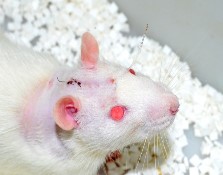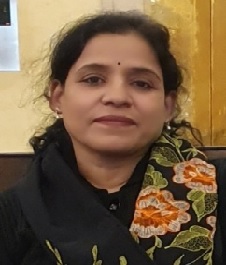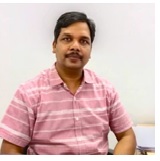Faculty
- Last Updated On :
Department of Anatomy
Prof. S.B. Ray (Prof. & Head)

M.S. (BHU), D.N.B., M.N.A.M.S
Professor
Address : Room No. 1009, Ist Floor
PC Block
Deptt of Anatomy
AIIMS, N. Delhi
Phone : 011-26593216
Professional Experience after post-graduation:
-
Senior Demonstrator (IMS, BHU) : 1989-1991
-
Senior Demonstrator (AIIMS, N. Delhi) : 1991-1993
-
Assistant Prof. : 1993-1998
-
Associate Prof : 1998-2005
-
Additional Prof. : 2005-2008
-
Professor : (2008 -2018)
-
Professor (HAG) : 2019 onwards
Research Focus: Pain arising from burn injury is a devastating experience for patients. Results of our research in rodents show that blocking the B2 subtype of bradykinin receptor produces significant relief from burn-induced pain. An attempt to test this alternative hypothesis in a clinical trial to be conducted in the largest burn unit in the country could not be done, due to lack of funds. Other putative drugs, which have shown efficacy in rodents are the cannabinoid type 1 receptor and the somatostatin type 2A receptor agonist. These could relieve specific parameters of pain like pain-at-rest but not touch-induced allodynia.
Publications: 1. George J. et al. 2014. J Burn Care Res 35:e391-398 (Published by American Burn Association)
2. Kumar R. et al. 2016. Indian J Med Res 144:730-740.
3. Kumar R. et al. 2018. Eur J Anaesthesiol 35:955-965.

Intrathecal catheterization with drug administration in rodents is a novel technique for simulating intraspinal administration of drugs during cardiac surgery. I underwent training at the Anesthesia Research Laboratory of University of California at San Diego for 3 months in 2008. It was supported by an International biomedical associateship grant from Indian Council of Medical Research, N. Delhi.
Substance P receptor antagonists when administered through catheters in rodents proved effective in ameliorating post-operative pain. A more potent effect was obtained when it was combined with local peripheral administration.
Publications: 1. Gautam M et al. 2016. Spinal Cord 54:172-182.
2. Gupta S et al 2018. Ann Neurosci 25:268-276.
Current research work is focused on developing rat models of (1) Neuropathic pain by partial sciatic nerve ligation (2) Osteoarthritis by intra-articular injection of monoiodoacetate. Both are chronic diseases which compromises the quality of life.
PhD students:
-
Dr. Rakesh Kumar Pandey (2012)
-
Dr. Pranav Prasoon (2016)
-
Dr. Mayank Gautam (2018)
-
Dr. Rahul Kumar (2019)
-
Dr. Shivani Gupta (2020)
-
Mr. Amit Kumar
Current M.D. & MSc students:
-
Dr. HH Hanusan
-
Dr. Akhila MS
-
Ms. Kajol
Teaching experience outside AIIMS, N. Delhi
Assistant Prof at B. P. Koirala Institute of Health Sciences, Nepal in 1997.
Prof. Rima Dada
Prof. Rima Dada did her MBBS from Delhi University at Maulana Azad Medical College. Thereafter, she joined the MD programme in Anatomy at the University College of Medical Sciences, again under Delhi University. She completed her Senior Residency and her Ph.D. studies in Genetics at AIIMS, New Delhi. Later, she joined AIIMS as an Assistant Professor in the Department of Anatomy.
Teaching, Research, Training and Genetic (Human Cytogenetic and Molecular) Diagnostic services Genetic Diagnostic and patient care services: Both cytogenetic and molecular techniques used for analysis of various genetic disorders eg- Reproductive disorders (premature ovarian failure, Recurrent spontaneous abortion, various endocrinal disorders, infertility, congenital malformations, Glaucoma, Congenital cataract, BPES, Retinoblastoma and various hematological disorders and cancers. Also offering Sperm DNA damage and seminal ROS assessment facility to couples with idiopathic infertility and cases with recurrent ART failure.
Research interests: Genetics of reproductive disorders, ocular disorders and various childhood cancers. Also studying impact of lifestyle interventions on markers of aging.
Prof. Rima Dada is on the editorial board of several national and international journals and member of various scientific bodies.She has been awarded several prestigious national and international awards and has several international and national indexed papers and book chapters.
Publications:
-
Bisht S, Faiq M, Tolahunase M, Dada R. Oxidative stress and male infertility. Nat Rev Urol. 2017 Aug;14(8):470-485. doi: 10.1038/nrurol.2017.69. Epub 2017 May 16. PMID: 28508879.
-
Dada T, Bhai N, Midha N, Shakrawal J, Kumar M, Chaurasia P, Gupta S, Angmo D, Yadav R, Dada R, Sihota R. Effect of Mindfulness Meditation on Intraocular Pressure and Trabecular Meshwork Gene Expression: A Randomized Controlled Trial. Am J Ophthalmol. 2021 Mar;223:308-321. doi: 10.1016/j.ajo.2020.10.012. Epub 2020 Oct 22. PMID: 33393484.
-
Tolahunase MR, Sagar R, Faiq M, Dada R. Yoga- and meditation-based lifestyle intervention increases neuroplasticity and reduces severity of major depressive disorder: A randomized controlled trial. Restor Neurol Neurosci. 2018;36(3):423-442. doi: 10.3233/RNN-170810. PMID: 29614706.
-
Tolahunase M, Sagar R, Dada R. Impact of Yoga and Meditation on Cellular Aging in Apparently Healthy Individuals: A Prospective, Open-Label Single-Arm Exploratory Study. Oxid Med Cell Longev. 2017;2017:7928981. doi: 10.1155/2017/7928981. Epub 2017 Jan 16. Erratum in: Oxid Med Cell Longev. 2017;2017:2784153. PMID: 28191278; PMCID: PMC5278216.
-
Gautam S, Tolahunase M, Kumar U, Dada R. Impact of yoga based mind-body intervention on systemic inflammatory markers and co-morbid depression in active Rheumatoid arthritis patients: A randomized controlled trial. Restor Neurol Neurosci. 2019;37(1):41-59. doi: 10.3233/RNN-180875. PMID: 30714983.
-
Gautam S, Kumar U, Kumar M, Kanga U, Dada R. Association of HLA-G 3'UTR Polymorphisms with Soluble HLA-G Levels and Disease Activity in Patients with Rheumatoid Arthritis: A Case-Control Study. Immunol Invest. 2020 Feb;49(1-2):88-105. doi: 10.1080/08820139.2019.1657146. Epub 2019 Sep 5. PMID: 31549885.
-
Gautam S, Kumar U, Kumar M, Rana D, Dada R. Yoga improves mitochondrial health and reduces severity of autoimmune inflammatory arthritis: A randomized controlled trial. Mitochondrion. 2021 May;58:147-159. doi: 10.1016/j.mito.2021.03.004. Epub 2021 Mar 17. PMID: 33741520.
-
Gautam S, Kumar M, Kumar U, Dada R. Effect of an 8-Week Yoga-Based Lifestyle Intervention on Psycho-Neuro-Immune Axis, Disease Activity, and Perceived Quality of Life in Rheumatoid Arthritis Patients: A Randomized Controlled Trial. Front Psychol. 2020 Sep 2;11:2259. doi: 10.3389/fpsyg.2020.02259. PMID: 32982898; PMCID: PMC7492675.
-
Venkatesh S, Kumar R, Deka D, Deecaraman M, Dada R. Analysis of sperm nuclear protein gene polymorphisms and DNA integrity in infertile men. Syst Biol Reprod Med. 2011 Jun;57(3):124-32. doi: 10.3109/19396368.2011.562960. Epub 2011 Mar 22. PMID: 21425891.
Prof. Arundhati Sharma

Prof. Arundhati Sharma did her graduation (B. Sc) and post graduation (M. Sc) in Genetics and Molecular Biology from Osmania and Pune University, respectively. She did her Ph D in Human Genetics from Nizam’s Institute of Medical Sciences and did her subsequent post doctoral work in the Department of Medical Genetics, SGPGIMS, Lucknow. Later, she joined as Assistant Professor of Genetics in the Department of Anatomy, AIIMS. Her work includes teaching, training and providing diagnostic facilities in the field of Human genetics. Her laboratory provides the following:
Diagnostic and patient care services- conventional cytogenetic services (Karyotyping) and other chromosomal studies. Molecular cytogenetic services using fluorescent in-situ hybridization (FISH) for various genetic numerical and structural abnormalities, cancers and other genetic conditions. Research interests include genetics of various endocrine and eye disorders, identification of biomarkers for prognostic and diagnostic purposes for various cancers and adverse drug reactions, and studies of Addiction genetics, i.e. identification of the genetic contribution to alcohol and drug dependence.
Publications:
-
Marik B, Bagga A , Sinha A , Khandelwal P , Hari P , Sharma A. Genetic and clinical profile of patients with hypophosphatemic rickets. Eur J Med Gen 21 June 2022. https://doi.org/10.1016/j.ejmg.2022.104540.
-
Vanathi M, Kishore A, Gupta Y, Setty PB, Sen S, Nag TC, Gupta R, Sharma A, Tandon R. Recurrence in Reis Bücklers corneal dystrophy: Clinicopathological correlation. Indian J Ophthalmol Case Rep 2022; 2:371-5.
-
Chakraborty S, Sharma A, Bagchi I, Pal S, Bhattacharyya C, Gupta V, Maitra A, Bhattacharjee S, Sharma A, Sihota R, Acharya M. A genomewide association study on individuals with occludable angles identifies potential risk loci for intraocular pressure. J Genet. 2021;100:69. PMID: 34608871
-
Sarkar S, Singh R, Sharma A, Pandit MA, Gupta R, Singhal D, Jain R, Balhara YP. Association of Serotonergic Pathway Gene Polymorphisms With Behavioral Parameters in Patients With Opioid Dependence. Cureus. 2021 Nov 6;13(11):e19310. doi: 10.7759/cureus.19310. PMID: 34900485; PMCID: PMC8647861
-
Gupta V, Somarajan BI, Kaur G, Gupta S, Singh R, Pradhan D, Singh H, Kaur P, Sharma A, Chawla B, Pahuja A, Ramachandran R, Sharma A. Exome sequencing identifies procollagen-lysine 2-oxoglutarate 5-dioxygenase 2 mutations in primary congenital and juvenile glaucoma. Indian J Ophthalmol. 2021 Oct;69(10):2710-2716. doi: 10.4103/ijo.IJO_1750_21. PMID: 34571620; PMCID: PMC8597539.
-
Gupta V, Somarajan BI, Gupta S, Walia GK, Singh A, Sofi R, Chaudhary RS, Sharma A. The mutational spectrum of Myocilin gene among familial versus sporadic cases of Juvenile onset open angle glaucoma. Eye (Lond). 2021;35(2):400-408.
-
Grover T, Gupta R, Arora G, Bal CS, Ambekar A, Ray SB, Vaswani M, Sharma A. Dopamine transporter availability in alcohol and opioid dependent subjects – a 99mTc-TRODAT1SPECT imaging and genetic association study. Psychiatry Res Neuroimaging. 2020; 305:111187. doi: 10.1016/j.pscychresns.2020.111187. Online ahead of print.
8. Bansal M, Tandon R, Saxena R, Sharma A, Sen S, Kishore A, Venkatesh P, Maiti S, Chakraborty D. Ophthalmic genetics practice and research in India: Vision in 2020. Am J Med Genet C Semin Med Genet. 2020 Sep;184(3):718-727
9. Kathpalia P, Nag TC, Chattopadhyay P, Sharma A, Bhat MA, Roy TS, Wadhwa S. In ovo Sound Stimulation Mediated Regulation of BDNF in the Auditory Cortex and Hippocampus of Neonatal Chicks. Neuroscience. 2019; 408: 293-307. doi: 10.1016/j.neuroscience. 2019.04.014. Epub 2019 Apr 24.
Prof. Renu Dhingra

Dr Renu Dhingra joined BSc (Hons) Human Biology at AIIMS, then completed her MSc (Anatomy) at AIIMS, followed by a PhD. She further worked as a Senior Demonstrator in the Department of Anatomy, AIIMS. Later, she joined University College of Medical Sciences, New Delhi as a Lecturer and thereafter at Gulf Medical College Ajman, UAE. Subsequently, she joined the department of Anatomy at AIIMS as an Assistant Professor.
Her research interest is in placental biology. At present, she is working on ‘apoptotic, oxidative endoplasmic reticulum stress and angiogenetic markers in pre –eclampsia . Her current research also focuses on migration and invasion studies on trophoblastic cells. The laboratory has the infrastructure for handling cell lines, conducting in-vitro assays, apoptotic, cytotoxic assays and other molecular biology techniques like ELISA, Immunofluorescence, Western Blot and PCR.
She has established the Plastination laboratory in the department. The plastinated specimens serve as valuable adjuncts for teaching Anatomy to undergraduate and postgraduate students.
Publications:
-
Arora P, Dhingra R, Bhatla N, Sharma A. VEGF and sFlt-1 polymorphisms in Preeclampsia. Placenta 2016; 45: 118–119
-
Arora P, Kshetrapal P, Bhatla N, Rani N, Mochan S, Gupta SK, Saxena S, Dhingra R. Matrix metalloproteinase 2 and tissue inhibitor of metalloproteinase- 2 mRNA levels in early onset preeclampsia. Placenta 2017; 51:131-132
-
Gupta SK, Bhatla N, Rani N, Mochan S, Saxena S, Arora P, Dhingra R. Hydrogen sulphide producing enzymes are decreased in placentas from preeclampsia. Placenta. 2017; 51: 131.
-
Mochan S, Bhatla N, Rani N, Gupta SK, Saxena S, Arora P, Dhingra R. SFLT-1 induces endoplasmic reticulum stress by activating perk pathway in bewo cells Placenta. 2017; 51: 131.
Prof. Ritu Sehgal
Dr. Ritu Sehgal graduated from Maulana Azad Medical College (MAMC) and completed her MS Anatomy and Senior Residency from the same institution. She was awarded the ‘Pyare Lal Sharma & Bishan Devi Gold Medal’ for Best thesis/student in Pre & Paraclinical Subjects. She joined AIIMS as Assistant Professor of Anatomy after working for a brief period as Assistant Professor at VMMC, New Delhi
Research interest: receptors expression in breast cancer and medical education
Publications
-
Kumar A, Sehgal R, Roy TS. A morphometric analysis and study of variations of foramina in the floor of the middle cranial fossa. J Anat Soc India 2016; 65(2): 143-147.
-
Deshmukh VR, Singh S, Sehgal R. Cysto-duodeno-colic ligament and its clinical relevance. Biomed J 2016; 39(6): 414-416.
Dr.Saroj Kaler
Dr. Saroj Kaler Jhajhria joined as assistant professor in the Anatomy department (AIIMS) in 2012. She did her M.B.B.S. from S.M.S. Medical College, Jaipur (Rajasthan). She completed MD and senior residency in Anatomy from the All India Institute of Medical Sciences (AIIMS), Delhi in 2008 and 2011 respectively. She is an active participant for Medical Education workshops & seminars and cadaveric workshops. Her interest includes neurobiology, toxicology and gross anatomy. She has administrative charge of the Gross Anatomy Lab (Dissection Hall).
Publications:
-
Kaler S, Gupta S, Prasoon P, Gautam M, Ray SB. Role of calcitonin gene-related peptide in nociception resulting from hind paw incision in rats. J Anat Soc India 2017; 66: 7–14
-
Banerjee A, Kumari C, Kaler S. Variation in the branching pattern of third part of Axillary artery- A Case Report. J Clin Diagn Res 2017; 11 (2): 3- 41.
-
Kumari C, Motwani R, Kaler S, Rani N, Jain P, Raza K, Dhawan V, Singh S. Higher Right Kidney and Partial Duplication of Left Ureter. Int. J Anat Res 2017; 5: 3788-3790
-
Gautam M, Prasoon P, Kumar R, Reeta KH, Kaler S, Ray SB. Role of neurokinin type 1 receptor in nociception at the periphery and the spinal level in the rat. Spinal cord-Nature 2016; 54: 172-182
-
Prasoon P, Gupta S, Kumar R, Gautam M, Kaler S, Ray SB. Role of fosaprepitant, a neurokinin Type 1 receptor antagonist, in morphine‑induced antinociception in Rats. Ind J Pharmacol 2016; 48 (4): 394-398
Dr. Tony George Jacob

Tony joined AIIMS as faculty in 2014. He is continuing his work on the pathogenesis of pancreatitis. Now, he and his team have also established two surgical models of acute pancreatitis in rats at the Institute, which also measures organ dysfunction. He is also working on two models of chronic pancreatitis. His work includes the role of autophagy, cell death and inflammation in the pathogenesis of acute and chronic pancreatitis. He also studies the development and effect of aging on the various components of the human auditory system.
He is interested in teaching various aspects of anatomy and has a special interest in history, especially that of medical education. He is also a resource person for Mentoring, Interpersonal Communication Skills and Personality Development in the Health Sector and also for medical research, writing a manuscript and the process of reviewing and editing.
Publications
-
Indrapal, Paltati CRB, Saini S, Kaur C, Kumar P, Bhardwaj DN, Jacob TG, Roy TS. Morphological and neurochemical changes in GABAergic neurons of the aging human inferior colliculus. Hearing Research. 2019. March 2019. Hearing Research 377. DOI:10.1016/j.heares.2019.02.005
-
Poorna Pillutla SV, Kaur C, Roy TS, Jacob TG. Estimation of Volume of Stria Vascularis and the Length of Its Capillaries in the Human Cochlea. J Microsc Ultrastruct. 2019 Jul-Sep;7(3):117-123. doi: 10.4103/JMAU.JMAU_12_19. PMID:31548922
-
Saini S, Kaur C, Pal I, Kumar P, Jacob TG, Thakar A, Roy KK, Roy TS. Morphological development of the human cochlear nucleus. Hear Res. 2019 Oct; 382:107784. doi: 10.1016/j.heares.2019.107784. Epub 2019 Aug 20. PMID:31522073
-
Kaur C, Saini S, Pal I, Kumar P, Sati HC, Jacob TG, Bhardwaj DN, Roy TS. Age-related changes in the number of cresyl-violet-stained, parvalbumin and NMDAR 2B expressing neurons in the human spiral ganglion. Hearing Res. 2020. https://doi.org/10.1016/j.heares. 2020.107883
-
Kumar A, Faiq MA, Krishna H, Raj GV, Kishan V, Coffey JC, Jacob TG. Development of a Novel Technique to Dissect the Mesentery that Preserves Mesenteric Continuity and Enables Characterization of the Ex Vivo Mesentery. Front. Surg. 2020. doi: 10.3389/fsurg.2019.00080
-
Ahuja R, Sharma N, Vashisht P, Jacob TG, Narang R, Bhatnagar N. Biocompatibility Analysis of PLA based Candidate Materials for Cardiovascular Stents in a Rat Subcutaneous Implant Model. Acta Histochemica. 2020;122(7):151615. doi: 10.1016/j.acthis.2020.151615
-
Raghav R, Jain R, Jacob TG, Dhawan A, Roy TS. Co-administration of nalbuphine attenuates the morphine-induced anxiety and dopaminergic alterations in morphine-withdrawn rats. Psychopharmacology (Berl). 2021 Apr;238(4):1193-1211. doi: 10.1007/s00213-021-05765-3
-
Nag HL, Jain G, Vijayakumar V, Jacob TG, Sonai M, Lalwani S. Femoral Intercondylar Notch: Gross Anatomy and Histology of the Connective Tissue Lining of its Roof: A Pilot Study. Surg Rad Anat. 2021. doi.org/10.1007/s00276-021-02757-y.
-
Kumar P, Sharma S, Kaur C, Pal I, Bhardwaj DN, Vanamail P, Roy TS, Jacob TG. The ultrastructural study of human cochlear nerve at different ages. Hearing Research 2022. (in press). https://doi.org/10.1016/j.heares.2022.108443
-
M. Uppal, T.G. Jacob, H.N. Yadav, S.K. Datta, R. Yadav, S.J. Mahapatra, P. Garg, P. Sahni, Therapeutic Methylprednisolone and Infimab Decrease the Severity of Organ Dysfunction in Pancreatic Duct Ligation Model of Severe Acute Pancreatitis in Wistar Rats, HPB, Volume Supplement 3, 2021, Page S739, ISSN 1365-182X, https://doi.org/10.1016/j.hpb.2021.08.136.
-
Sharma MK, Priyam K, Kumar P, Garg PK, Roy TS, Jacob TG. Effect of calorie-restriction and rapamycin on autophagy and the severity of caerulein-induced experimental acute pancreatitis in mice. Front. Gastro (Therapy in Gastroenterology). 2022. Accepted for publication.
Chapter in books:
a) Changing populations of neurons and glia in human cochlear nucleus with aging- Chapter 12
b) Morphology of the human pancreas during development and aging- Chapter 4 P.C Rath, R. Sharma, S. Prasad Eds: Topics in Biomedical Gerontology.
c) Parija SC, Adkoli BV Eds: Effective Medical Communication- the ABCD of it. Chapter: Jacob TG, Sahni P: Publishing effectively and ethically. Springer Singapore. 2020. pp 123-130. doi: 10.1007/978-981-15-3409-6.
Dr. Neerja Rani

Dr. Neerja Rani is a graduate (BSc. Hons Human Biology) and postgraduate (MSc. Anatomy) and Ph D from All India Institute of Medical Sciences, New Delhi. She worked on ‘Apoptotic changes in placenta of preeclamptic patients’ for her Ph D. Her work received an award at the International Federation for Placental Association in 2007.
She worked as a Senior Demonstrator in the Department of Anatomy, AIIMS, as Assistant Professor at PGIMS, Rohtak and as Assistant Professor at Lady Hardinge Medical College. At present she is working as an Additional Professor in the Department of Anatomy, AIIMS. Her area of interest in research is preeclampsia in humans.
Publications:
1. Mochan S , Bhatla N, Rani N, Gupta SK , Saxena S , Arora P and Dhingra R. sFLT-1 induces endoplasmic reticulum stress by activating perk pathway in BeWo cells. Abstracts / Placenta. Mar2017; 51: 130-131.
2. Gupta SK, Bhatla N, Rani N, Mochan S, Saxena S, Arora P and Dhingra R. Hydrogen sulphide producing enzymes are decreased in placentas from preeclampsia. Abstracts / Placenta. Mar2017; 51: 131.
3. Arora P, Khetrapal P, Bhatla N, Rani N, Mochan S, Gupta SK, Saxena S and Dhingra R. Matrix metalloproteinase 2 and tissue inhibitor of metalloproteinase 2 mRNA levels in early onset preeclampsia .Abstracts / Placenta. Mar2017; 51: 131.
4. Deshmukh VR, Mandal RP, Kusuma H and Rani N. Accessory upper subscapular Nerve- The Neurotization tool. J Clin Diagn Res. 2016 Sep; 10(9): AD01–AD02
5. Jain P, Raza K, Singh S, Kumari C, Kaler S, Rani N. Lumbar sympathetic chain: anatomical variation and clinical perspectives. Clin Ter 2016; 167 (6):185-187
Dr. Seema Singh
Dr. Seema Singh is a MBBS graduate from KMC Mangalore. She completed her MD and senior residency in Anatomy from AIIMS, New Delhi. She joined Lady Hardinge Medical College as assistant professor (Contractual basis) in 2013. Presently, she is an Additional professor in the Department of Anatomy, AIIMS. Her interest includes enteric nervous system, medical Education and gross anatomy.
Publications
-
Raza K, Singh S, Rani N, Mishra R, Mehta K, and Kaler S. Anomalous innervation of the median nerve in the arm in the absence of the musculocutaneous nerve. . Sultan Qaboos University Med J. Feb 2017; 17(1): e106–e108.
-
Deshmukh V, Singh S, Rani N, Baruhee D. Variation in the obturator vasculature during routine anatomy dissection of a cadaver. Sultan Qaboos University Med J. August 2016; 16 (3): 356–358.
-
Banerje A, Singh S, Raza K, Rani N, Kaler S. Unilateral Variation in Extensor digitorum longus muscle. Clin Ter. 2016 Sep-Oct;167(5):150-151.
-
Kaushal P and Singh S. Variations in the extensor muscles of hand: A Case Report. Int Med J 2016; 23(2):189 - 191.
-
Singh S, Shariff A, Roy T, Das T, Rani N. Development of myenteric plexus in human foetuses: a quantitative study. Anat Cell Biol. 2015;48(2):124-129.
Dr. Subhash Chandra Yadav
Dr. Subhash Chandra Yadav did Ph.D. (2007) in Molecular Biology from Banaras Hindu University (BHU), Varanasi, India. He was visiting researcher (from 2005 to 2006) at the Institute of Crystallography, Free University (FU) Berlin, Germany. He was a postdoctoral fellow at Molecular Biophysics Unit, Indian Institute of Science (IISc), Bangalore Karnataka (2007-08) India and Medical Center, University of Tennessee, Knoxville, TN USA (2008). He worked as a Scientist In charge of nanobiology and electron microscopy facility at the Institute of Himalayan Bioresource Technology (CSIR-IHBT) Palampur H.P. India from 2008 to 2011. He was employed as a Fellow at TERI-Deakin University (Australia) Nanobiotechnology Centre (TDNBC), New Delhi, from 2011 to 2015. He joined the Electron Microscope Facility, Department of Anatomy, AIIMS, New Delhi, as an Assistant Professor in 2015, Associate Professor in 2018, and currently an Additional Professor since 2021 of 3D Electron Tomography, Electron Microscopy, and Nanotechnology. He was visiting professor at Stanford University, the USA, in 2019-20.
Research interest:
Electron Tomography and Nanobiology, Development of nanotechnology-based diagnostics system, Targeted drug delivery vehicles and therapeutic efficacy improvement of biomolecules.
Patent:
Raman S, Tanwar P, Bhatla N, Yadav SC. An Immuno-Nano-Fluorescence Assay, Antibodies and a Kit Thereof for Detection of Human Papillomavirus (HPV) Infection Associated Cervical Cancer. Indian Patent 2021, 202111035011 (Filed 03.08.2021)
Tiwari M, Dinda A, Yadav SC, Bhat M. Cancer Detection System, Patent Number; 400170, Application Number: 201611011074, dated 28.06.2022 (Indian patent granted)
Publication:
-
Chaudhary S, Rai P, Joshi A, Yadav P, Sesham K, Kumar S, Mridha AR, Baitha U, Nag TC, Soni KD, Trikha A, Yadav SC. Ultracellular imaging of bronchoalveolar lavage from young age COVID-19 patients with comorbidities showed greater SARS-CoV-2 infection but lesser ultrastructural damage than the old age patients. Microscopy and Microanalysis 2022; 6 doi: 10.1017/S1431927622012430 IF: 4.099, Citation:0
-
Kumar S, Frid MG, Zhang H, Li M, Riddle S, Brown R, Yadav SC, Roy MK, Dzieciatkowska ME, D’Alessandro A, Hansen KC, and Stenmark KR. Complement containing small extracellular vesicles from adventitial fibroblasts induce proinflammatory and metabolic reprogramming in macrophages. JCI Insight. 2021; 6:e148382 IF: 8.315, Citation:5
-
Chaudhary S, Rai P, Sesham K, Kumar S, Singh P, Nag TC, Chaudhuri P, Trikha A & Yadav SC: Microscopic imaging of bronchoalveolar fluids of COVID-19 positive intubated patients reveals the different level of SARS-CoV-2 infection on oral squamosal epithelial cells. Indian Journal of Biochemistry & Biophysics 2021; 58:196-207. IF: 1.98, Citation: 3
-
Mridha AR, Barwal I, Gupta A, Majeed A, Barwad AW, Kumar VS, Gamanagatti S, and Yadav SC*: Processing Techniques for Scanning Electron Microscopy Imaging of Giant Cells from Giant Cell Tumors of Bone. Microscopy and Microanalysis, 2019; 25:1376-1382. IF: 3.414
-
Barwal I, Kumar R, Dada T, and Yadav SC: Effect of Ultra-Small Chitosan Nanoparticles Doped with Brimonidine on the Ultra-Structure of the Trabecular Meshwork of Glaucoma Patients. Microscopy and Microanalysis 2019; 6:1352-66. IF: 4.099, Citation: 5
-
Barwal I, Kumar R, Kateriya S, Dinda AK, Yadav SC. Targeted delivery system for cancer cells consist of multiple ligands conjugated genetically modified CCMV capsid on doxorubicin GNPs complex. Nat Sci Report 2016; 6:37096. IF: 5.516, Citation: 32
-
Ghosh S, Sinha JK, Khan T, Devaraju KS, Singh P, Vaibhav K, Gaur P. Pharmacological and therapeutic approaches in the treatment of epilepsy. Biomedicines, 2021; 9, 470.
-
Chaturvedi V, Kabale, P, Singh P. Biofabrication of Silver Oxide Nanoparticles (SO-NP) by autolysate of Pseudomonas mendocina PM1, and assessment of its antimicrobial/anti-biofilm potential. Indian Journal of Biochemistry and Biophysics, 2021; 58 (4), 373-380.
-
Chaudhary S, Rai P, Sesham K, Kumar, Singh P, Nag TC, Chaudhuri P, Trikha, Yadav SC. Microscopic imaging of bronchoalveolar fluids of COVID-19 positive intubated patients reveals the different level of SARS-CoV-2 infection on oral squamosal epithelial cells. Indian Journal of Biochemistry & Biophysics, 2021; 58 (3), 196-207
-
Singh P, Peng DW, Suo WZ. Stereological estimation of cholinergic fiber length in the Nucleus Basalis of Meynert of the mouse brain. Journal of Visualized Experiments, 2020;(156):e60405.
-
Suo WZ, Peng DW, Singh P, Ding XF. A standardized anxiety quotient in elevated open platform task quantifies rodent anxiogenic tendency with improved reliability and sensitivity. Neuroscience, 2019; 423:12-17.
-
Singh P, Das TK. Ultrastructural localization of 4-hydroxynonenal adducts in fluoride exposed cells: protective role of dietary antioxidants. Fluoride, 2019; 52 (1): 49-58
-
Khristi V, Chakravarthi VP, Singh P, Ghosh S, Pramanik A, Ratri A, Borosha S, Roby KF, Wolfe MW, Rumi MAK. ESR2 regulates granulosa cell genes essential for follicle maturation and ovulation. Molecular and Cellular Endocrinology, 2018; 474:214-226.
-
Rumi MAK, Singh P, Roby KF, Zhao X, Iqbal K, Ratri A, Lei T, Cui W, Borosha S, Dhakal P, Kubota K, Chakraborty D, Vivian JL, Wolfe MW, Soares MJ. Defining the role of estrogen receptor beta in the regulation of female fertility. Endocrinology, 2017;158 (7): 2330-2343
-
He M, Singh P, Cheng S, Zhang Q, Peng W, Premont R, Morgan D, Burns J, Swerdlow R, Suo W. GRK5 deficiency leads to selective basal forebrain cholinergic neuronal vulnerability. Scientific Reports, 2016; 6:26116
-
Singh P, Zhang Q, Peng W, Suo W. GRK5 renders susceptibility to intermittent hypoxia-induced cognitive impairment. Behavioural Brain Research, 2016;302: 29-34
Dr. Prabhakar Singh
Publications
- Ghosh S, Sinha JK, Khan T, Devaraju KS, Singh P, Vaibhav K, Gaur P. Pharmacological and therapeutic approaches in the treatment of epilepsy. Biomedicines, 2021; 9, 470.
- Chaturvedi V, Kabale, P, Singh P. Biofabrication of Silver Oxide Nanoparticles (SO-NP) by autolysate of Pseudomonas mendocina PM1, and assessment of its antimicrobial/anti-biofilm potential. Indian Journal of Biochemistry and Biophysics, 2021; 58 (4), 373-380.
- Chaudhary S, Rai P, Sesham K, Kumar, Singh P, Nag TC, Chaudhuri P, Trikha, Yadav SC. Microscopic imaging of bronchoalveolar fluids of COVID-19 positive intubated patients reveals the different level of SARS-CoV-2 infection on oral squamosal epithelial cells. Indian Journal of Biochemistry & Biophysics, 2021; 58 (3), 196-207
- Singh P, Peng DW, Suo WZ. Stereological estimation of cholinergic fiber length in the Nucleus Basalis of Meynert of the mouse brain. Journal of Visualized Experiments, 2020;(156):e60405.
- Suo WZ, Peng DW, Singh P, Ding XF. A standardized anxiety quotient in elevated open platform task quantifies rodent anxiogenic tendency with improved reliability and sensitivity. Neuroscience, 2019; 423:12-17.
- Singh P, Das TK. Ultrastructural localization of 4-hydroxynonenal adducts in fluoride exposed cells: protective role of dietary antioxidants. Fluoride, 2019; 52 (1): 49-58
- Khristi V, Chakravarthi VP, Singh P, Ghosh S, Pramanik A, Ratri A, Borosha S, Roby KF, Wolfe MW, Rumi MAK. ESR2 regulates granulosa cell genes essential for follicle maturation and ovulation. Molecular and Cellular Endocrinology, 2018; 474:214-226.
- Rumi MAK, Singh P, Roby KF, Zhao X, Iqbal K, Ratri A, Lei T, Cui W, Borosha S, Dhakal P, Kubota K, Chakraborty D, Vivian JL, Wolfe MW, Soares MJ. Defining the role of estrogen receptor beta in the regulation of female fertility. Endocrinology, 2017;158 (7): 2330-2343
- He M, Singh P, Cheng S, Zhang Q, Peng W, Premont R, Morgan D, Burns J, Swerdlow R, Suo W. GRK5 deficiency leads to selective basal forebrain cholinergic neuronal vulnerability. Scientific Reports, 2016; 6:26116
- Singh P, Zhang Q, Peng W, Suo W. GRK5 renders susceptibility to intermittent hypoxia-induced cognitive impairment. Behavioural Brain Research, 2016;302: 29-34










